Ever overcooked a pork loin? It's easy to do with a lot of pork cuts, but especially a roast where the center takes longer to get fully cooked than the outside. Making it in the sous vide means it's all but impossible to overcook. That's because the meat can't get hotter than the water bath temperature. This technique is a game-changer for pork loin, bringing the roast to the perfect level of doneness. It also ensures a tenderness that's hard to achieve with traditional methods. One thing you should know up front: while optional, for best results you'll want to salt it overnight.
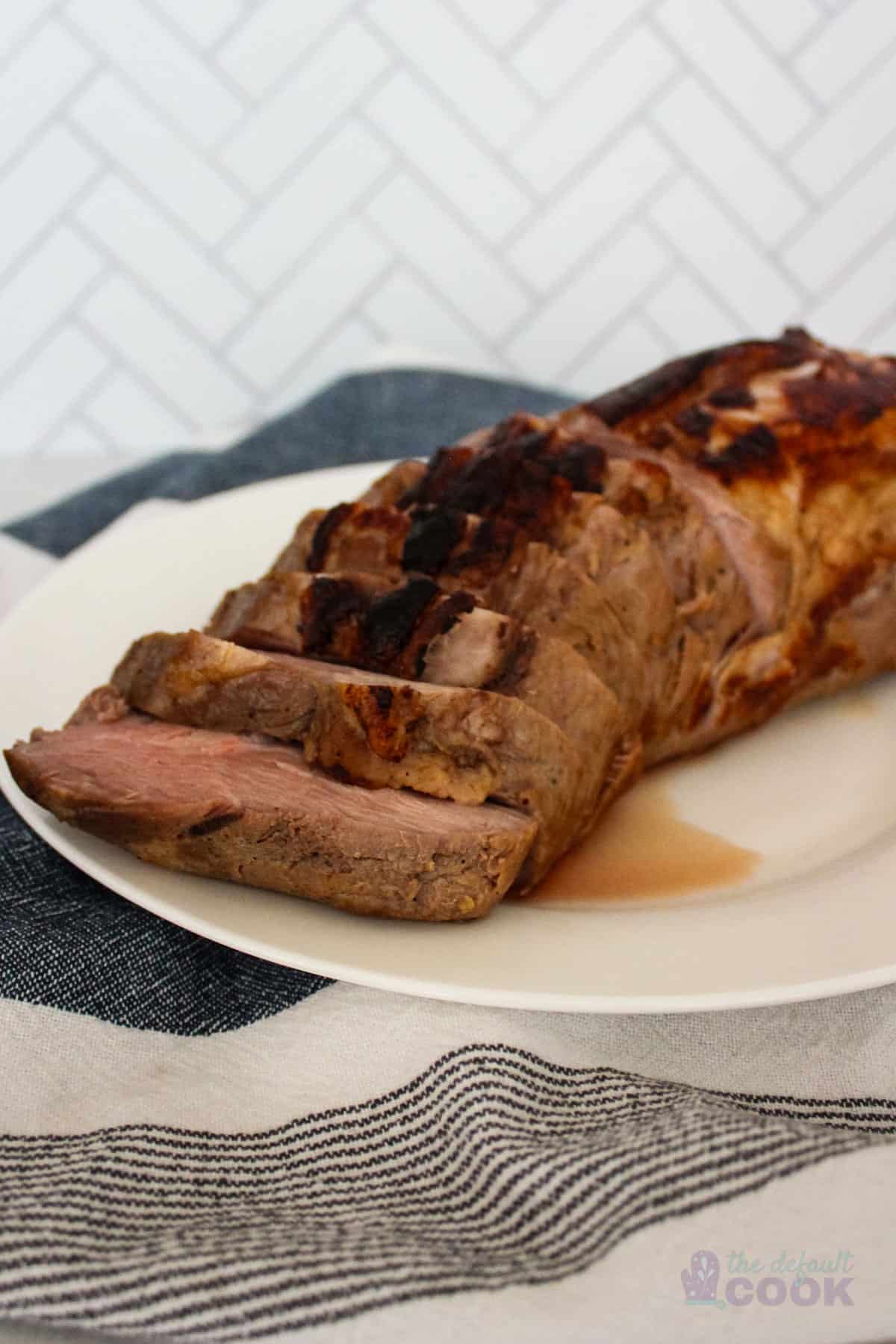
So What Is Sous Vide?
Sous Vide is a cooking method that hails from France, and literally means "under vacuum" in French. While we don't need a vacuum sealer, it involves cooking our food in a bag that we've removed (at least most of) the air from in a water bath. The water bath is kept at a precise temperature with a sous vide precision cooker. That means whatever you're cooking ends up with an internal temperature that is exactly the temperature of the water- no more overcooked food!
Don't let the fancy name deter you. Despite its gourmet reputation, the sous vide method is surprisingly simple and approachable. It's fantastic option for cooks of any skill level!
Why You'll Love This Sous Vide Pork Loin
- Easy Marinade: With just 3 ingredients in the sauce itself and some sliced garlic, you probably have everything you need in the kitchen right now.
- Perfectly Cooked: Juicy and flavorful, you'll be able to easily avoid under or overcooking here. I honestly think sous vide is the best way to prepare a pork loin.
- Freezer Friendly: Once you've added the marinade you can freeze the whole loin raw and cook it from frozen on a busy day.
Let's Get Started! Here's What You'll Need:
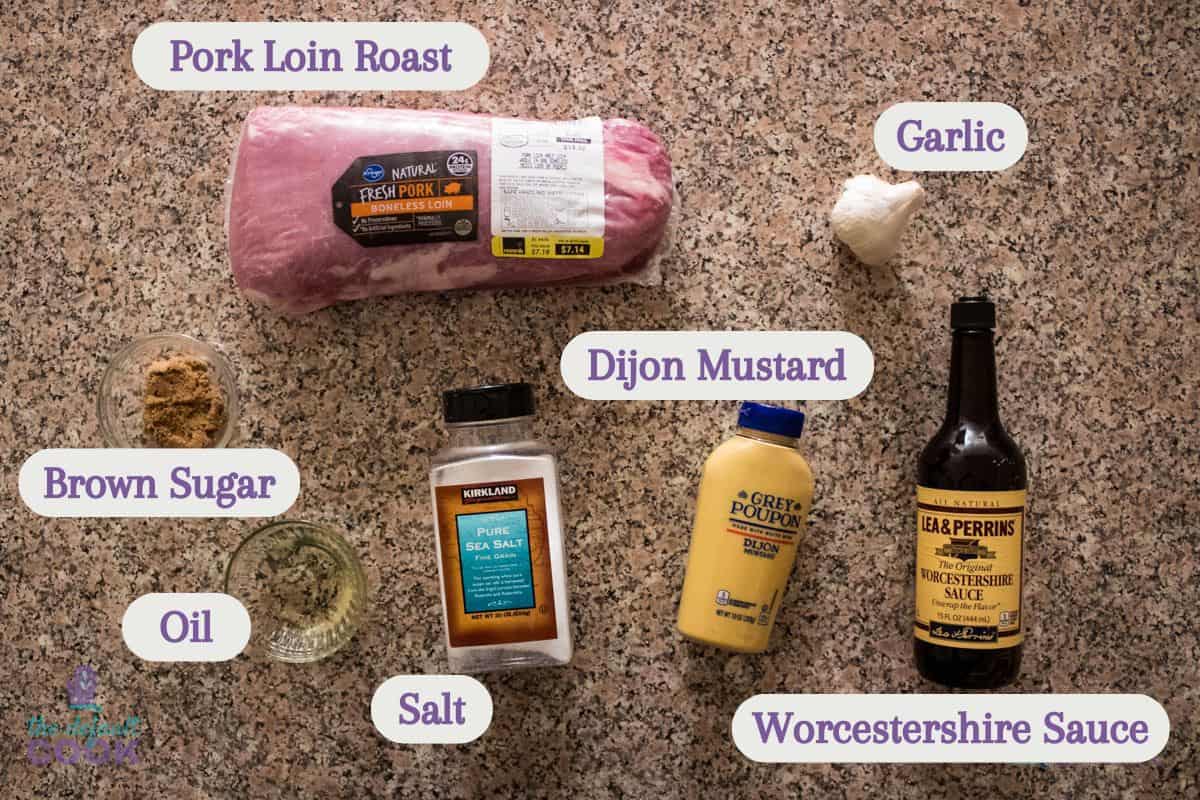
Ingredients
3-3.5 pound boneless pork loin roast: This lean pork cut is our star- it's different from a pork tenderloin which cooks faster. A larger roast might take a bit longer but the main reason to keep it under 4 pounds is so that it fits in your zip top bag. Of course, you can always cut it to size and use the remainder for pork chops in another meal if yours doesn't quite fit.
Salt: A tablespoon or so to tenderize the roast overnight.
Garlic: Fresh is preferable here not just because it gives more flavor than preminced, but because we're going to remove it after cooking but before searing to avoid burning it. That's easy enough with slices, but annoying at best with minced garlic. If you can't use fresh opt for garlic powder instead.
Brown sugar, Dijon mustard, and Worcestershire sauce: These 3 combine in equal parts to create a flavorful but easy marinade.
Oil: One with a high smoke point like canola oil or avocado oil, this helps us get a great crisp exterior at the end. I've used olive oil in a pinch, but it's not ideal for getting this hot.
Equipment
Our MVP will be our sous vide machine. We'll also need a container large enough for the water bath, be that a dedicated sous vide container or a large stock pot, and chip clips to secure the sous vide bag in place. For the bag you can use a vacuum sealer if you have one, but it's just as easy to use a gallon size freezer bag and displace the air with the water bath. For mixing the marinade we'll want a small bowl and fork or whisk, measuring spoons, and a knife and cutting board for the garlic. After cooking we'll need some paper towels to dry the roast, a skillet to sear it in and tongs to do that. At the very end we'll want to tent the roast with aluminum foil to rest, and a knife and cutting board for slicing.
Step-by-Step Instructions
Step 1: Prep the Pork
Begin by massaging about 1 tablespoon of salt all over the pork loin roast, then place it in a gallon ziplock bag to rest overnight (or any container if you're using a vacuum seal bag instead). This step really helps tenderize the meat, plus is less prep to do in the morning.

Step 2: Make the Marinade
The next day, whisk together the brown sugar, dijon mustard, and Worcestershire sauce in a small bowl or container. Slice the garlic cloves and add them to the marinade, then pour everything into the bag with the pork. Let it marinate for at least 30 minutes so the flavor can start getting into the meat before cooking.
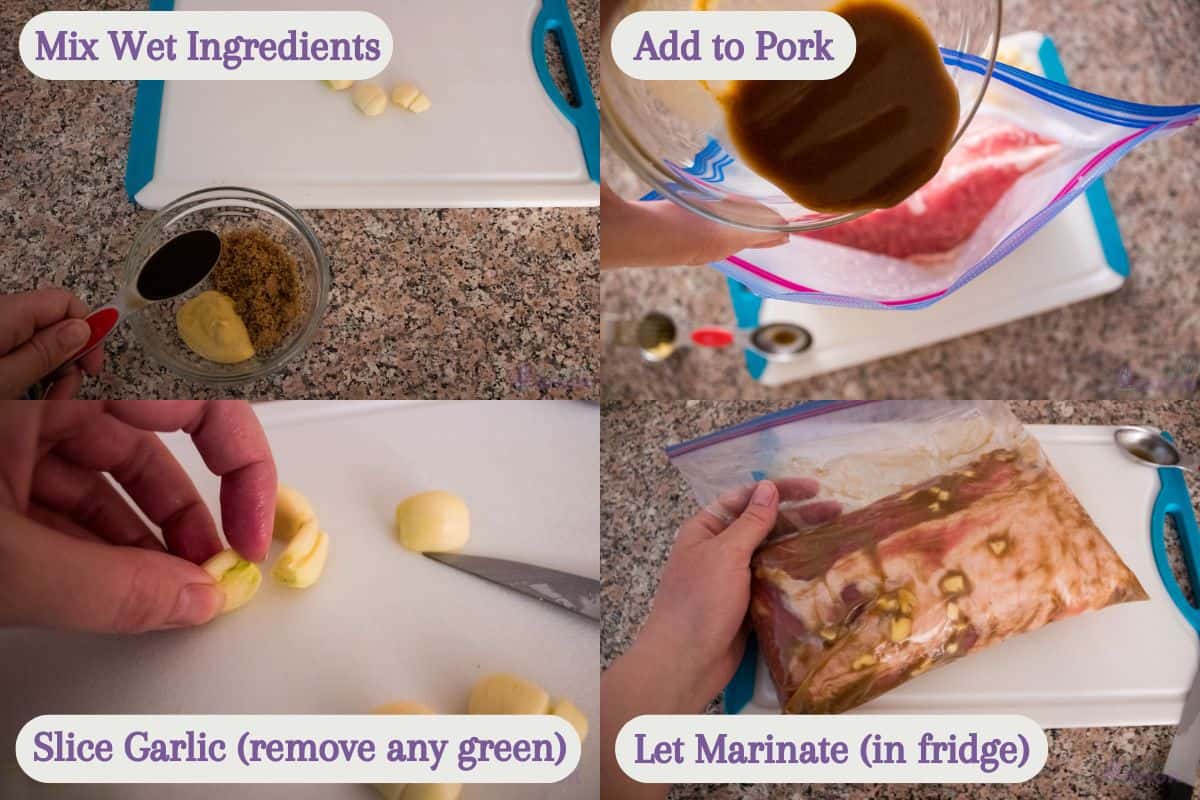
Tip: If your garlic is green in the middle, it's still OK to use. The green will be bitter though, so you'll want to remove that part.
Step 3: Remove the Air (Water Displacement method)
If you have a vacuum sealer follow the instructions that came with that- if you're using a gallon ziploc bag like I am then grab your large pot and fill it most of the way up with water. Take your gallon bag of marinating pork loin and close it about ¾ of the way at the top, then place the bottom of the bag in the water. Use your hands to slowly work the air in the bag up and out of the ¼ that's open. As you do this you can submerge more of the bag (but not the open part!) into the water to keep air from going back in. Once you have as much air out as you can get, fully close the top of the bag. If you want to freeze this to cook another day, this is the best point to do that.
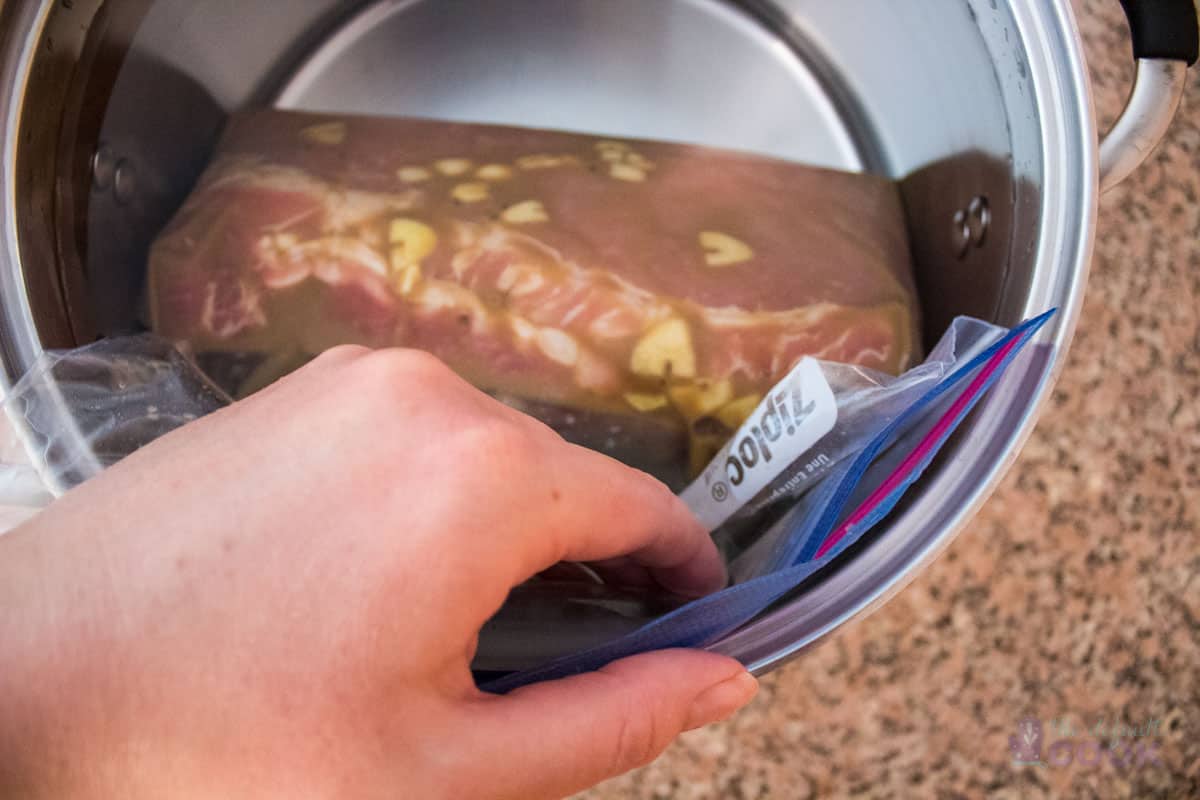
Step 4: Sous Vide Cooking
Now that the air is out of your cooking bag, grab a chip clip (or sous vide magnets if you're fancy) and secure your roast to the side of the sous vide water bath. Make sure the meat is fully submerged, and set the water temperature on your sous vide cooker to 140 degrees F. Cook the pork loin in the water bath for 5-6 hours, or 7-8 hours if you'd frozen it after step 3. While you don't really need to do anything while it cooks, I check to make sure the roast hasn't gravitated towards the circulator and that the water line hasn't fallen below the top of the meat when I'm walking through the kitchen at lunch.
Step 5: Dry & Sear
Now our roast is fully cooked, but to get that delicious crust on the outside and frankly, a prettier presentation, we're going to give it a quick sear. You can do that on a hot grill, or on the stove in a skillet. Either way, the first thing we'll do is remove the pork from the sous vide bag. Next pat it dry with some paper towels, and remove any garlic slices that stuck to the roast so they don't burn during searing.

If we don't pat it dry the moisture on the roast will create steam when it hits the hot pan, which will keep us from getting that nice crust in a time frame that doesn't overcook the meat. Heat a tablespoon or so of oil in a skillet over high heat and sear the pork for about 1 minute on each side.
Step 6: Rest & Slice
After searing your sous vide pork roast, place it on a cutting board or platter and tent with aluminum foil. After about 10 minutes, slice the rested pork loin into slices, and serve immediately. If you have any leftover pork be sure to store it in an airtight container.

FAQs
I recommend freezing first if you'll be cooking for more than 8 hours. While it takes awhile, the meat cooked long enough will over-tenderize and can be an unpleasant texture, particuarly on the ends that come to temperature faster than the middle. Starting the roast from frozen buys you another 2 hours, so you can go up to 10 hours without worrying about that. You'll also want to make sure everything is clipped and secured very well if you won't be around to check on it, and that your water line won't drop below the top of the meat.
Absolutely! This marinade is an easy and flavorful one, but you can use your favorite. Feel free to experiment with the marinade or even use a dry rub and fresh herbs.
You'll want to use a high quality zip top bag and make sure the bag is secured so that it won't be pulled to the inlet of your immersion circulator. While the water will be the right temperature, the surface of the circulator itself can be hotter and could damage the bag.
A roast is just chops that haven't been cut up, if you need this to cook faster you can absolutely slice your raw roast into 1-2" thick chops instead. Place the chops in a single layer in a bag, and cook it for 2 hours. In that case, one bag likely won't hold the whole roast. You can either freeze the rest, or cook with two bags if your water bath container is large enough.
More Sous Vide Recipes
Have a pork tenderloin instead? Check out this sous vide pork tenderloin recipe. Want to try sous vide with chicken? Here's an easy sous vide chicken teriyaki option. Or opt for beef, which sous vide is probably best known for with this sous vide tri tip or sous vide short ribs.
Need some side options? Pork and sweet potatoes go together like peanut butter and jelly! You can roast sweet potato slices for a quicker option, or make mashed sweet potatoes in your crock pot in about the same amount of time as the pork.
Enjoy!
I hope you love this flavorful pork roast and find that sous vide takes the guesswork out of cooking for you. Happy cooking, I can't wait to hear about your sous vide adventures!
📖 Recipe

Sous Vide Pork Loin Roast
Ingredients
- 3.5 lb pork loin
- 1 tablespoon sea salt
- 4 cloves garlic
- 1.5 tablespoon brown sugar
- 1.5 tablespoon dijon mustard
- 1.5 tablespoon worcestershire sauce
- 1 tablespoon oil for searing
Instructions
- Salt the roast generously and place in a zip top bag in the fridge to tenderize, ideally overnight.
- Whisk together equal parts brown sugar, dijon mustard, and worcestershire sauce. Pour over pork loin. Slice garlic cloves and add to bag as well, then marinate in the fridge for at least 30 minutes.
- Using the water displacement method, remove air from the zip top bag and cook in a 140 degree sous vide bath for 5-6 hours.
- Remove roast from bag and discard garlic slices. Pat dry, then add oil to a hot skillet and sear for 1 minute on each side.
- Tent roast with aluminum foil and let rest for 10 minutes, then slice and serve hot.
Notes
Nutrition
Nutrition information is provided as a courtesy and is an estimate. It is recommended to use your preferred calculator with the actual ingredients you use for optimal accuracy.



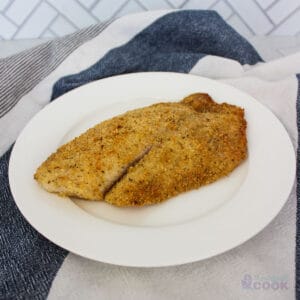

Leave a Reply